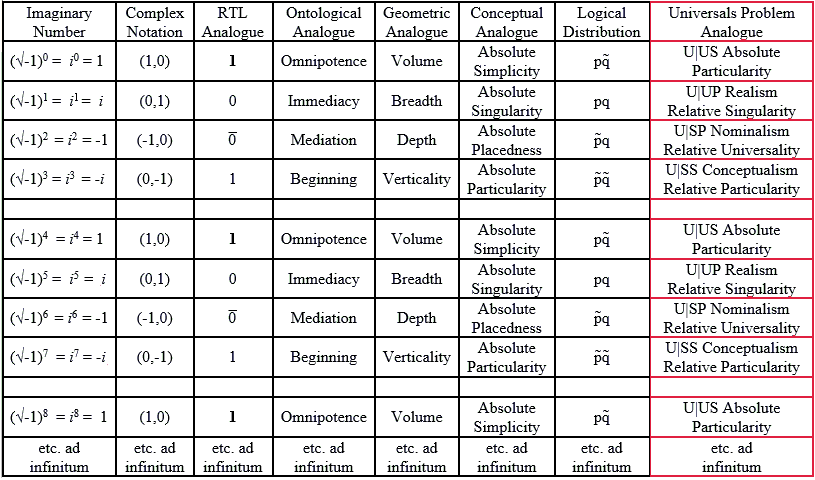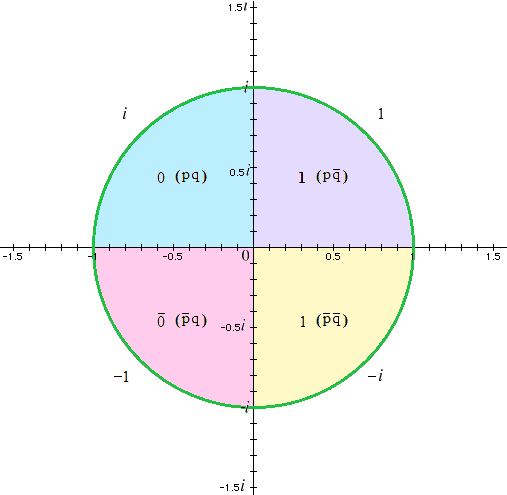1
Cf. D.G. Leahy, Beyond Sovereignty: A New Global Ethics and
Morality (Aurora, 2010).
2
Cf. D.G. Leahy, Foundation: Matter the Body Itself (Albany,
1996), Section III.1.
3 Cf., above, nn. 1 and 2; also, D.G. Leahy, Novitas Mundi: Perception of the History of Being (Albany, 1994), "Prolegomena" and "Appendices α, β, and γ".
4 Leahy, Foundation, Section III.1.
5
The reduction of the sequence pq + p̅q + pq̅ + p̅q̅ to the
mathematical framework of the Cartesian coordinate system, + +, − +,
+ −, − −, makes it possible to elucidate the deep structure of the
conceptualist equation Sr2 = SS = (UP)2.
In the sequence UP + SP + US + SS, when + and – are
predicated of the respective elements qua unity, the last term SS is
equivalently
−12.
This S, the singular as such, is then, qua
−1, the square of the imaginary number i
= √−1:
i2 = (√−1)2
=
−1 (cf. the equivalents of the real trinary logic elements (1,
0,
![]() , 1) in Leahy, Beyond Sovereignty, Backnote 4, Table
4, et passim, and, on this web,
Real Trinary Logic, the Imaginary Number i, & the Cyclic
Series of Complex Numbers.
The singular as such −1, here, corresponds to absolute
placedness i2, on the scale employed
loc. cit.,
the square of absolute singularity).
Thus the coherence of the conceptualist notion of the
exhaustion of the generic in mente as the nameable whole
radically imaginary is rendered patent: SS =
−12 = (√−1)4
= i4
= (UP)2 = 12 (cf.,
ibid.,
where i4 corresponds to Omnipotence).
, 1) in Leahy, Beyond Sovereignty, Backnote 4, Table
4, et passim, and, on this web,
Real Trinary Logic, the Imaginary Number i, & the Cyclic
Series of Complex Numbers.
The singular as such −1, here, corresponds to absolute
placedness i2, on the scale employed
loc. cit.,
the square of absolute singularity).
Thus the coherence of the conceptualist notion of the
exhaustion of the generic in mente as the nameable whole
radically imaginary is rendered patent: SS =
−12 = (√−1)4
= i4
= (UP)2 = 12 (cf.,
ibid.,
where i4 corresponds to Omnipotence).
6
Transposing the OLO 1, 2, 4, 3 to the minimum order (MO) 4, 1, 2, 3
(cf., above, n. 2), the proportion U|US (Absolute Particularity) :
U|UP (Realism) :: U|SP (Nominalism) : U|SS (Conceptualism)
simplified by reduction to either S−1 : P−1 ::
(SS) −1 : (SP)−1 or −1 : 1 :: 1 : −1 proves in
both forms to Unity (= i4, as above, n. 5).
Note that the penultimate form of the proportion confirms
that Nominalism (the Real Unnameable) and Conceptualism (the
Nameable Imaginary) are each the other’s reciprocal, respectively,
(SS)−1 and (SP)−1.
The ratio (SS)−1 : (SP)−1 further
simplified produces the ratio S−1 : P−1—transforming
the reciprocal relation in the ultimate form of the proportion above
(−1 : 1 :: 1 : −1) to identity (−1 : 1 :: −1 : 1) at once the form
of the original proportion unreduced—precisely
the form of the ratio of Absolute Particularity (the Real Absolutely
Named) to Realism (the Real Nameable), the elements of which ratio
are related as befits the ‘absolute originality’ of the MO
‘fourth/fourthness’ (cf. Leahy, Foundation, Section IV.1) not
as essential reciprocals the one of the other but indeed as
contradictories. See,
also, on this web,
Real Trinary Logic, the Imaginary Number i, & the Cyclic
Series of Complex Numbers where Omnipotence, on the scale there
employed, corresponds to absolute singularity identified with
absolute particularity as i4 = i1 ∙ i3.
The conceptual correspondence here (OLO 4): U|US: the universal
restricted to the singular identified with the universal,
i.e., identified with the singular identified with the particular.

Vis-à-vis the ordinary logic of mathematical proportion note the
following departure therefrom shared by the logic of complex
numbers and the real trinary logic of the thinking now occurring:
1) It is ordinarily true for all proportions composed of four discrete
elements that the product of the lesser elements divided by the
greatest element = the square of the least element.
2) Where these discrete elements are related to one another by
discrete powers of the antecedent in the ratio of the second to the
first the underlying form of this constant is that of all logical
statements pq, p̅q, pq̅, p̅q̅, where p = the first element not
multiplied by x, and q = the first element not multiplied by
y. Thus, the
aforementioned constant mathematical relation is logically
equivalent to the relation (pq × p̅q × pq̅)/p̅q̅ = (pq)2.
See, for example, on this web,
Epitome or Food for Thought, the sequence, where x =
82944 and i(x) = the integral product of x
(note: here i = integral product is not to be confused with
i = imaginary number),
[i(x)/9]/i[i(x)/9],
i(x)/9, i(x), (i[i(x)/9][i(x)])
= 113.7̅7̅7, 9216, 82944, 6718464 = pq, p̅q, pq̅, p̅q̅, where p =
113.7̅7̅7 not multiplied by 92 and q = 113.7̅7̅7 not
multiplied by 93. In
accord with the stated rule, (pq × p̅q × pq̅)/p̅q̅ = (pq)2,
(113.7̅7̅7 × 9216 × 82944)/6718464 = 113.7̅7̅72.
Likewise,
ibid.,
the sequence M (mass), M/T (mass flow rate), M/T2
(surface tension), M/T3 (Poynting vector) = pq, p̅q, pq̅,
p̅q̅, where p = M not multiplied by T−1, and q = M not
multiplied by T-2.
In accord with the stated rule, (pq × p̅q × pq̅)/p̅q̅ = (pq)2,
(M × M/T × M/T2)/(M/T3) = M2.
3) But
where i is the imaginary number, the sequence
i,
i2,
i3,
i4 may be logically
equivalent to pq, p̅q, pq̅, p̅q̅ (as above), but it may as well be
equivalently pq, p̅q, p̅q̅, pq̅, where p = i not multiplied
by i, since not previously so, or, since previously so
multiplied, by -i, and q = i not multiplied by –i,
and the relation between the last term and the product of its
predecessors, productive of the square of the first term, (i
×
i2
× i3)/i4
= i2,
will have the form (pq × p̅q × p̅q̅)/pq̅ = (pq)2.
a)
On the analogy of the division in extreme and mean ratio whereby
uniquely the whole line is divided but once to provide the elements
of a geometrical proportion, so where p̅
and q̅
each ordinarily provide one of two multiples of i necessary
to produce i4
the latter in the case of the cycle of imaginary numbers is
nevertheless uniquely also able to be produced by multiplying but
once by q̅.
b)
The relation of the real trinary logic elements 0,
![]()

c) The departure of the cycle of complex numbers from the ordinary logico-mathematical order of the form of proportions (above, para. 3), while real, is not unlimited. While |z| = 1 is the shared absolute value of the complex numbers i, –1, –i, and 1 in the unit circle of the complex plane, the latter itself is not beyond the + and – framework of the x/y plane. Where the complex numbers are grounded so, real trinary logic, on the other hand, is by analogy grounded in the always positive x > y pq̅ that is 1 = i4 and is, so grounded, consistently beyond the + and – framework of the x/y plane.
d)
That the complex plane falls short of the absolute indifference of
the elements of real trinary logic to the + and – framework is
demonstrable when real trinary logic
![]()
![]() 0
= 1 placed analogously alongside the x > y negative form
i
×
–1 = –i (complex notation 0,–1) is positive (complex notation
1,0) and consistently so as 1
0
= 1 placed analogously alongside the x > y negative form
i
×
–1 = –i (complex notation 0,–1) is positive (complex notation
1,0) and consistently so as 1
![]()
![]()
![]()
e)
In the case of the complex numbers where
–i
×
–1
×
i
=
–1 the end product is
the included middle
–1,
i.e., the end product is not the excluded middle
–i
×
i
= 1. Were the middle
here the excluded middle then the end product would be
–i
×
1
×
i
=
1 = i4
=
pq̅.
But,
as it is, where the end product is the included middle
–1, the end product is the return of the cycle itself upon itself in
the form of the included middle, prematurely folding back upon
itself perpetually foreclosing arriving at positive foundational
unity 1.
In contrast, in the case of real trinary logic, where
1
![]()
![]()
![]()
![]() 0 =
0 =
![]()
![]()
![]()
![]() 0
=
0
=
![]()
![]()
![]()
f)
Where 1 = i4
=
pq̅, the real trinary logic end product immediately preceding, p = 0
not multiplied by 1, since not previously so, or, since previously
so multiplied, by 0, and q = 0 not multiplied by
![]()
![]() (demonstrably
existent, as above,
(demonstrably
existent, as above,
![]()
![]()
![]()
g)
Summarily: (–i
×
–1
×
i
= –1) : (1
![]()
![]()
![]()
For mediation and omnipotence, and relative vs. absolute
discontinuity of the continuum, cf. Leahy, Beyond Sovereignty,
passim, for the former and the latter, and Backnote 4, Tables 1-2,
for the former. For the excluded vs.
included middle, cf. Leahy, Faith and Philosophy, Chapter 7.
For dyadic ternary vs. real trinary logic, cf. Leahy,
Foundation III.1, Afterword 2, and “Appendix: The
De Trinitate of Augustine and the Logic.”
4)
Where the cyclic relation of the powers of i is understood as
this logico-mathematical departure from the ordinary form a
discretionary contextual relation surfaces that makes a real
logico-mathematical
difference as p̅, whose configuration here is fully consonant with
the real trinary logic fundamental operator
![]() ‘since’
(cf. Leahy, Foundation, Section III.1, and, above, passim), at once with the first
appearance of p̅ in the "Index of the Ethics of Simplicity" indeed in
association with Discretion p̅q (see, on this web,
Beyond the Superego: The
Pneumasomatic Human Person).
‘since’
(cf. Leahy, Foundation, Section III.1, and, above, passim), at once with the first
appearance of p̅ in the "Index of the Ethics of Simplicity" indeed in
association with Discretion p̅q (see, on this web,
Beyond the Superego: The
Pneumasomatic Human Person).
5) Cf. also the table above, where, on the analogy to i in the cycle of complex numbers, the logical equivalent of Omnipotence is pq̅ = i4, related as such to Immediacy pq = i, Mediation p̅q = i2, and Beginning p̅q̅ = i3, and compare this with, on this web, ibid., "The Index of the Ethics of Simplicity," where, likewise, the logical equivalent of Omnipotence is pq̅, related as such to Readiness pq, Discretion p̅q, and Beneficence p̅q̅, where p = not discriminating, and q = not doing.
7 For the identity of concept and percept, cf. Leahy, Foundation, passim.